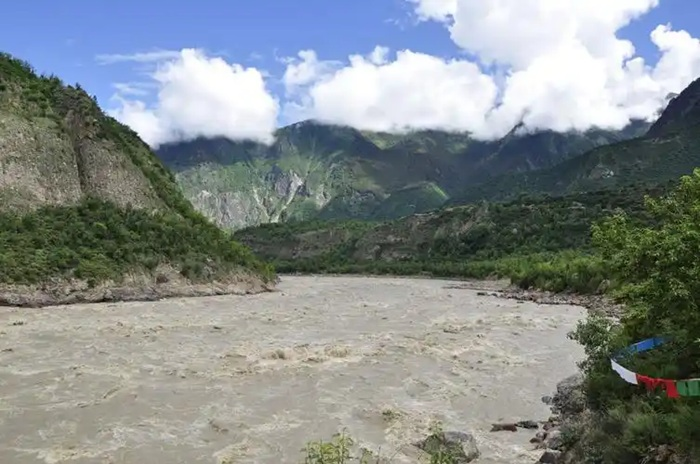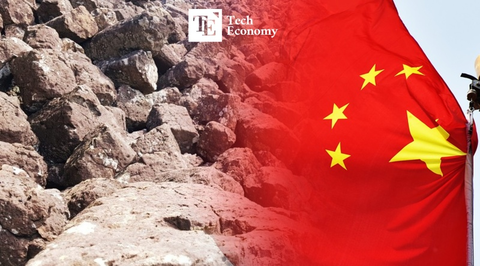China Breaks Ground on Tibet Megadam Despite Indian Opposition, Igniting Water Hegemony Tensions in Asia
Input
Modified
$177 Billion Invested in World’s Largest Hydropower Project Harnessing High-Altitude Terrain for Maximum Energy Efficiency India and Bangladesh React with Strong Protests over 'Survival Threat'

China has launched the world’s largest hydropower project in the Tibet region with a total investment of approximately $177 billion. The dam construction project, which had been delayed for more than a decade, is now finally underway. The issue is that the river in question flows into Bangladesh and merges with India. Downstream countries like India express concerns that the Chinese hydropower project may cause environmental degradation and fear that China could weaponize water.
Construction Ceremony for Yarlung Tsangpo River Hydropower Project
According to state-run Xinhua News Agency on the 21st, Chinese authorities held a groundbreaking ceremony on the 19th for the “Lower Yarlung Tsangpo River Hydropower Project” in Linzhi, Tibet Autonomous Region, attended by Premier Li Qiang. The project is being carried out by Power Construction Corporation of China (POWER CHINA) and is scheduled for completion in 2033.
Facing increasing pressure to reduce greenhouse gas emissions, China aims to decrease reliance on coal-fired power plants while effectively addressing the electricity shortfall stemming from the expansion of electric vehicles and artificial intelligence (AI) industries. At the same time, this project—the largest single hydropower initiative in history—is expected to contribute to the development and economic revitalization of underdeveloped western regions, including the Tibet Autonomous Region. Chinese authorities have stated that the project will generate an annual income of about $2.8 billion for Tibet.
China had announced its intention to build hydropower dams on the Yarlung Tsangpo River more than a decade ago. Originating at an altitude of over 3,000 meters in the Tibetan Plateau, the Yarlung Tsangpo River is fed primarily by glacial meltwater from the Himalayas and stretches 2,840 km in length. It also boasts the world’s largest canyon, more than 5,000 meters deep. One segment of this river falls over 2,000 meters in just 50 km, offering immense potential for hydropower generation.

“East Data, West Computing” Strategy Expands into Tibet
The Yarlung Tsangpo River is deemed an optimal site for hydropower under China’s "East Data, West Computing" initiative, which seeks to transfer data from the east to be processed in the west. Since launching the strategy in 2022, China has begun operating the Yajiang-1 supercomputing center on the Tibetan Plateau as of last month, aiming to build a sustainable high-performance computing hub.
Located in Shannan city in the Tibet Autonomous Region, the initial phase of the center will deploy more than 256 advanced computing servers capable of delivering a total of 2,000 petaflops (200 quadrillion floating-point operations per second). Jointly developed by Tibet Yarlung Tsangpo Computing Technology Company and local governments, the facility is designed to pioneer the "high-altitude digital economy."
As the first step in extending the East Data, West Computing strategy into Tibet, Yajiang-1 maximizes the region’s unique environmental conditions for sustainable operations. The high altitude naturally provides cooler temperatures, reducing the need for artificial cooling, while abundant solar, hydro, and wind resources lower operational costs. According to a report from the Shannan Investment Promotion Bureau, the center addresses the global challenge of balancing computing demands and environmental protection at an altitude of 3,600 meters by employing an innovative system combining solar power, waste heat recovery, and high-efficiency cooling.
This integrated approach maintains a power usage effectiveness (PUE) rating of under 1.3, achieving 40% higher energy efficiency than conventional data centers. Once the 2,000-petaflop Yajiang-1 reaches full capacity, it will handle 4 million hours of AI training annually for China’s eastern region—saving 320 million kWh of electricity and reducing carbon emissions by 280,000 tons per year. The investment bureau also reports that the on-site solar panels, covering 25,000 m², generate 48 GWh of clean power annually, while recovered server waste heat is used to warm nearby buildings, cutting coal consumption by 12,000 tons per year.
Concerns Over “Weaponization of Water” and Emerging Conflicts
The key issue is that the Yarlung Tsangpo River flows downstream into northeastern India and Bangladesh. Originating in the Qinghai-Tibet Plateau, it is a critical transboundary river in South Asia, eventually emptying into the Bay of Bengal. Accordingly, downstream countries like India and Bangladesh have formally demanded that China safeguard their interests, raising concerns that massive upstream dam construction could worsen monsoon flooding, intensify dry-season droughts, threaten water and food security, and damage ecosystems. The dam project requires boring at least four 20-km tunnels through the 7,782-meter-high Namcha Barwa Mountain, which may alter the river’s flow, heightening risks of water shortages, flooding, and landslides in India and Bangladesh.
Similar issues have already emerged on the Mekong River, which originates in Tibet and flows through Yunnan Province into Southeast Asia. Over the past decade, China has built numerous dams on the Mekong’s upper reaches, and neighboring countries like Thailand, Myanmar, and Laos have suffered from water shortages. Dam construction has also triggered nutrient depletion, obstructed fish migration, and led to vegetation loss downstream, disrupting the entire ecosystem. Fishermen in countries relying on the Yarlung Tsangpo River for their livelihoods are expected to suffer comparable consequences.
Above all, neighboring countries fear China may weaponize water by building multiple dams on the upper Yarlung Tsangpo. Although China claims it will coordinate with neighbors, there is no mechanism to enforce such cooperation, inevitably escalating tensions. India, which has long clashed with China, continues to protest vehemently against the dam project. The Indian Ministry of External Affairs previously warned it would “closely monitor the situation and take necessary steps to protect our interests” after China approved the project.
Some observers even speculate that the long-standing border dispute, temporarily defused late last year, could re-emerge. China and India fought a war over border issues in 1962, and in June 2020, a bloody skirmish broke out in the Galwan Valley in western Himalayas. Moreover, the two nations are currently engaged in another diplomatic standoff over the successor to the Dalai Lama, who has taken refuge in India. Given this already fraught relationship, the dam construction could become the catalyst for a deeper rift.





















